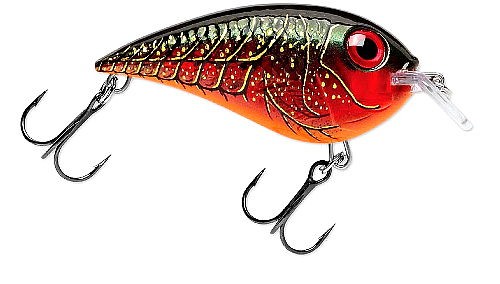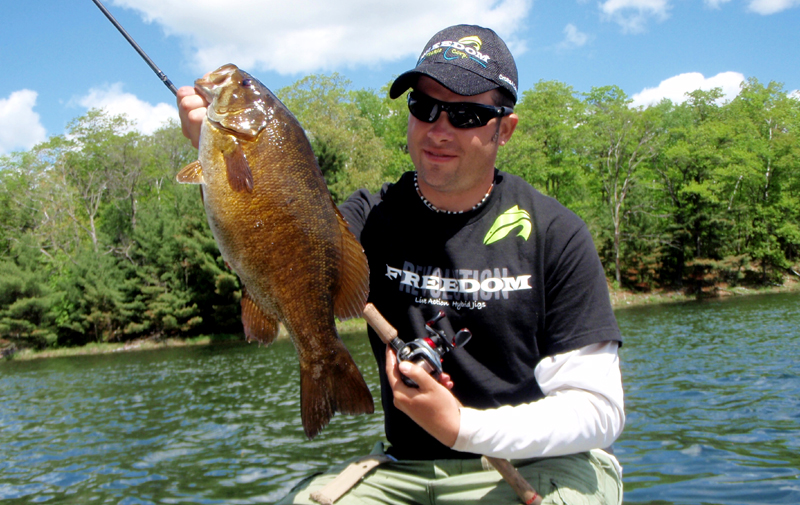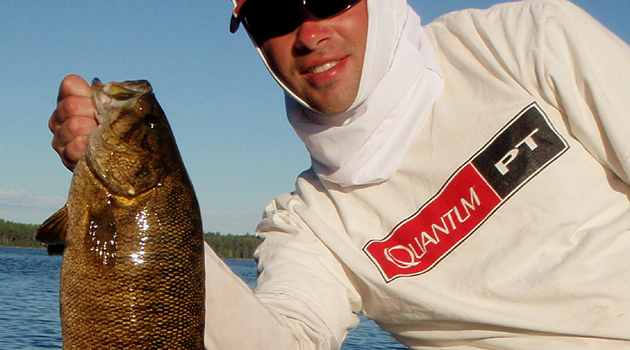The ideal smallmouth bass crankbait is a smaller, compact, realistic, and noisy representation of bottom-scurrying prey. In this case, it’s their favorite, the crayfish. In early spring as smallmouths prepare for their spawn, power cranking with a shallow diving crankbait will score big numbers of feisty, prespawn fish that are cruising the shallows for feeding, and settling near spawning sites.
Lake Profile
Size: 4,000 acres and 800 acres
Lake Type: Oligotrophic
Maximum Depth: 120 feet
Avg. Depth Fished: 5 to 10 feet
Water Clarity: Very Clear
Primary Fishery: Musky, Walleye, Smallmouth Bass
Areas of Focus: Sand and gravel bars, rock shoals, deep edges of spawning flats, wood
Time of Day: Midday and late afternoon
Rod & Reel: 7ft Quantum Tour Edition (medium) Quantum Catalyst 100SPTA
Line: Cortland Camouflage 10 lb.
Lure Used: Rapala Crankin Rap 05 (red crawdad)

On this early June 2014 day, I fished in Vilas County Wisconsin for some last-chance pre-spawn activity, targeting the largest and deepest lakes in the region. Two lakes were fished. The first part of the day was spent on a 4,000 acre lake in which the shallow crankbait bite was present and smallmouths up to 20 inches were caught. The day was then finished up on a new 800 acre lake never fished before, in which big smallmouths are caught from the extreme shallows with stealth using large Kalin’s swimming grubs, and the Strike King Coffee Tube. Despite having to fish these very large lakes long and hard in order to locate pre-spawn fish, I caught several nice specimens up to 20 inches.
Days before the spawn, fish like this were observed cruising in wolfpacks in depths as shallow as 1 foot deep. I was catching these mobile fish by staying mobile myself, raising the trolling motor and casting with the 5 inch Kalin’s swimming grub rigged with a minnow styled jig head. A second pattern was fish already utilizing shallow mid-lake structures near deep open water. Some fish were spawning in these locations while others were already using them as holding and feeding areas. Meanwhile, a secondary option was the reliable tube jig, as smallmouths wanted it meticulously scurried and dragged along the bottom. At this time, fish wanted nothing else besides a simple tube jig.
As illustrated in the video, under most circumstances I use a crankbait to search out cover and structure, looking for a reaction bite yet at the same time covering water in search for actively feeding fish. I don’t fish them slowly as one normally would with a fiberglass rod and a lower gear ratio reel. Rather, I power my way to ferocious strikes with speed and power. For this specific technique illustrated on the first lake in the video, I prefer fishing with a “power”reel with a 6:3.1 gear ratio. Quantum’s Catalyst 100SPTA is a perfect match, spooled with 10lb coplymer line and paired with a 7 foot medium action Quantum Tour Edition rod.
Modern crankbaits are available in all shapes and sizes, representing all types of bass forage and enabling bass anglers to cover all the bases when it comes to locating and catching fish. As we know, the favorite forage for smallmouth bass is the crayfish. Thus in my opinion, nothing works better than correctly matching the hatch.







